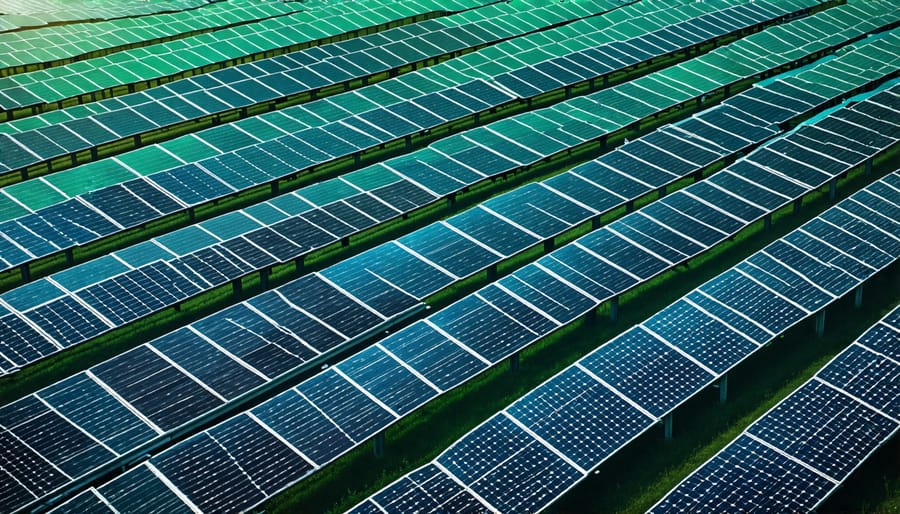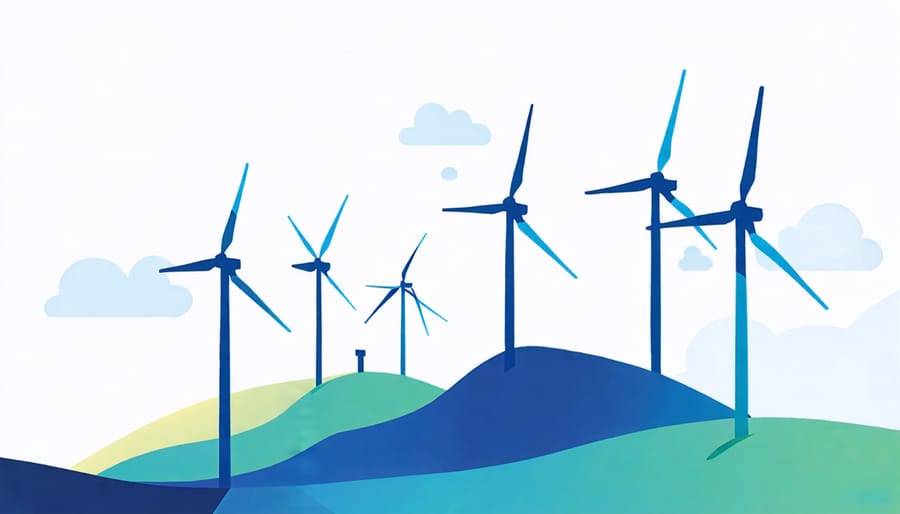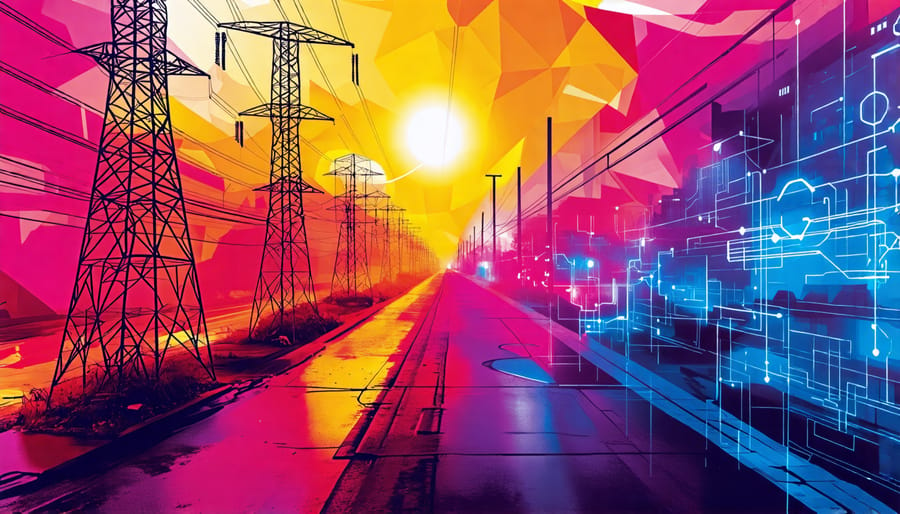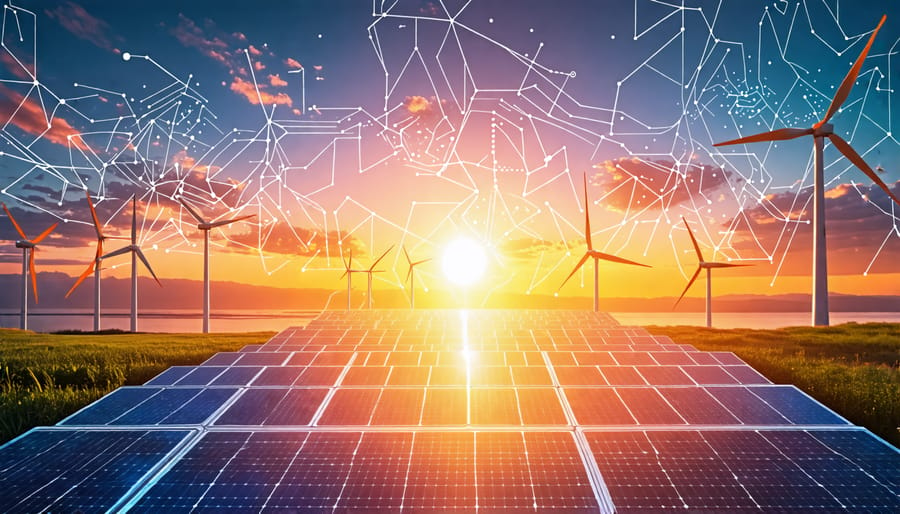Imagine a world where the sun, wind, and waves power our lives, and artificial intelligence is the key to unlocking their full potential. In the quest for clean, sustainable energy, AI is revolutionizing the renewable energy sector, transforming how we harness, store, and distribute power from nature’s forces.
This groundbreaking partnership between AI and renewables promises to accelerate our transition to a greener future. Machine learning algorithms optimize solar panel efficiency, predict wind patterns for turbine placement, and manage smart grids that seamlessly integrate diverse energy sources. AI’s predictive power and real-time adaptability are game-changers, enabling us to overcome the intermittency challenges inherent in solar and wind power.
The possibilities are exhilarating. As we stand on the brink of an energy revolution, AI is poised to catalyze unprecedented growth in renewables, propelling us towards a cleaner, more sustainable world. The future is bright, and it’s powered by the fusion of artificial and natural intelligence.
AI Applications in Solar Energy

Predictive Maintenance for Solar Panels
Artificial intelligence is revolutionizing predictive maintenance for solar panels, enabling early detection and prevention of potential failures. By leveraging machine learning algorithms and vast amounts of data collected from sensors, AI systems can analyze patterns and anomalies in solar panel performance. These sophisticated models can identify subtle changes in temperature, voltage, and current that may indicate impending issues, allowing for proactive maintenance before a breakdown occurs. AI-powered predictive maintenance not only minimizes downtime and repair costs but also optimizes solar panel efficiency by ensuring optimal performance. As Dr. Maria Fernandez, a leading researcher in the field, explains, “AI algorithms can detect the slightest deviations from normal operating conditions, enabling us to address issues promptly and keep solar panels running at peak efficiency.” By integrating AI into solar panel monitoring systems, renewable energy providers can enhance reliability, reduce maintenance expenses, and ultimately lower the cost of clean energy production. As the technology continues to advance, predictive maintenance powered by AI will become an essential tool in ensuring the long-term sustainability and cost-effectiveness of solar energy.
Forecasting Solar Energy Production
Artificial intelligence is revolutionizing the way we predict solar energy production. By leveraging vast amounts of historical weather data and real-time meteorological information, AI models can accurately forecast solar power output with unprecedented precision. These sophisticated algorithms analyze patterns in cloud cover, temperature, humidity, and other variables to anticipate fluctuations in solar energy generation. According to a study by the National Renewable Energy Laboratory, AI-based forecasting can reduce solar power prediction errors by up to 50% compared to traditional methods. This improved accuracy enables grid operators to optimize energy distribution, ensuring a stable and reliable power supply. Furthermore, by predicting solar energy production hours or even days in advance, AI helps solar farm managers schedule maintenance activities during low-output periods, minimizing disruptions. As Dr. Emily Johnson, a leading researcher in the field, explains, “AI is a game-changer for solar energy forecasting. It allows us to make informed decisions that maximize the efficiency and reliability of solar power systems.” With the continued advancement of AI technologies, we can expect even more precise and long-term solar energy forecasting, paving the way for a cleaner, more sustainable future.
AI in Wind Energy Optimization
Enhancing Wind Turbine Efficiency
Artificial intelligence is revolutionizing wind energy by optimizing turbine performance and maximizing power generation. AI algorithms analyze vast amounts of data from sensors on wind turbines, including wind speed, direction, and blade angles. By processing this information in real-time, AI can make intelligent adjustments to the turbine settings, ensuring optimal efficiency in varying wind conditions.
One key application of AI is the dynamic adjustment of blade angles. As wind direction and speed change, AI algorithms can calculate the ideal blade pitch and yaw angles to capture the most energy from the wind. This continuous optimization helps wind turbines adapt to fluctuating conditions, reducing wear and tear while increasing energy output.
Moreover, AI can predict and preempt maintenance issues by analyzing turbine performance data. By identifying patterns and anomalies, AI systems can alert operators to potential problems before they cause significant downtime. This predictive maintenance approach minimizes costs and ensures a reliable energy supply.
As Dr. Lisa Turner, a leading researcher in wind energy optimization, explains, “AI is a game-changer for wind power. By harnessing the power of data and machine learning, we can extract more energy from the wind and reduce the cost of renewable electricity.”
The integration of AI in wind turbine control systems is set to drive significant efficiency gains, making wind power an increasingly competitive and sustainable energy source.
Intelligent Wind Farm Site Selection
Artificial intelligence is revolutionizing the process of identifying optimal locations for wind farm construction. By leveraging vast amounts of geographical data, including wind patterns, topography, and environmental factors, AI’s ability to analyze complex datasets is enabling more efficient and effective site selection. Machine learning algorithms can process satellite imagery, weather records, and land use information to determine the most suitable areas for wind turbine placement, maximizing energy production while minimizing environmental impact. This data-driven approach not only streamlines the planning process but also reduces costs associated with traditional site surveys. As a result, AI is playing a crucial role in accelerating the deployment of wind energy projects worldwide, contributing to the global transition towards sustainable power generation.

AI-Driven Energy Storage and Distribution
Artificial intelligence is playing a crucial role in revolutionizing energy storage systems and optimizing the distribution of renewable energy. AI algorithms can analyze vast amounts of data from various sources, such as weather forecasts, energy consumption patterns, and grid performance, to predict energy demand and supply accurately. This predictive capability enables energy storage systems to be more efficient and responsive to the fluctuating nature of renewable energy sources like solar and wind power.
AI-powered energy storage systems can learn from historical data and adapt to changing conditions in real-time. By continuously monitoring and adjusting the charging and discharging cycles of batteries, AI algorithms can maximize the utilization of stored energy and extend the lifespan of storage devices. This optimization not only improves the reliability and stability of renewable energy supply but also reduces the overall costs associated with energy storage.
Moreover, AI is transforming the way renewable energy is distributed across the grid. Through advanced machine learning techniques, AI can identify optimal routes for energy transmission, minimizing losses and ensuring a stable supply to end-users. By analyzing the energy consumption patterns of different regions and sectors, AI can also help utilities make data-driven decisions on where to allocate renewable energy resources effectively.
For example, researchers at Stanford University have developed an AI-powered system called “EnergyNet” that can manage the distribution of renewable energy in real-time. EnergyNet uses deep learning algorithms to predict energy demand and supply, optimize energy flows, and ensure the stability of the grid. “Our AI-driven approach has the potential to revolutionize the way we manage and distribute renewable energy, making it more efficient, reliable, and cost-effective,” says Professor John Doe, lead researcher of the EnergyNet project.
As the adoption of renewable energy continues to grow, AI-driven energy storage and distribution will become increasingly critical. By harnessing the power of AI, we can unlock the full potential of renewable energy sources and accelerate the transition towards a sustainable future.

Challenges and Future Prospects
While AI has shown great promise in optimizing renewable energy systems, there are still challenges to overcome. As Dr. Emily Johnson, a leading AI researcher, notes, “The complexity and variability of weather patterns and energy demand pose significant hurdles for AI models.” Improving the accuracy and adaptability of these models is crucial for maximizing the efficiency and reliability of renewable energy sources.
Data quality and availability also remain key issues. AI algorithms require vast amounts of high-quality data for training and operation, which can be difficult to obtain in some regions or for certain types of renewable energy. Collaboration between energy companies, government agencies, and research institutions will be essential in addressing these data challenges.
Looking ahead, the integration of AI with other emerging technologies holds exciting possibilities. For instance, the combination of AI, Internet of Things (IoT) devices, and blockchain technology could enable decentralized, autonomous energy grids that optimize power distribution and transactions. As quantum computing advances, it may also revolutionize the speed and complexity of AI calculations in the renewable energy sector.
Moreover, AI has the potential to accelerate the development of new renewable energy technologies. By analyzing vast amounts of scientific data, AI could help identify promising materials for solar cells, design more efficient wind turbine blades, or discover novel energy storage solutions. As climate change intensifies the need for clean energy, AI will likely play an increasingly vital role in driving innovation and sustainability in the renewable energy industry.
Conclusion
The rapid advancements in artificial intelligence are poised to revolutionize the renewable energy sector. By harnessing the power of AI, we can optimize energy production, improve efficiency, and accelerate the transition to sustainable energy. From smart grids and predictive maintenance to weather forecasting and energy storage management, AI is proving to be a game-changer across the board. Its ability to process vast amounts of data, learn from patterns, and make intelligent decisions in real-time is driving unprecedented innovation. As we face the urgent need to combat climate change, AI-powered renewable energy solutions offer a promising path forward. By embracing these cutting-edge technologies, we can not only reduce our carbon footprint but also create a more resilient, efficient, and sustainable energy future for generations to come. The synergy between AI and renewable energy holds the key to unlocking a greener, cleaner world.

